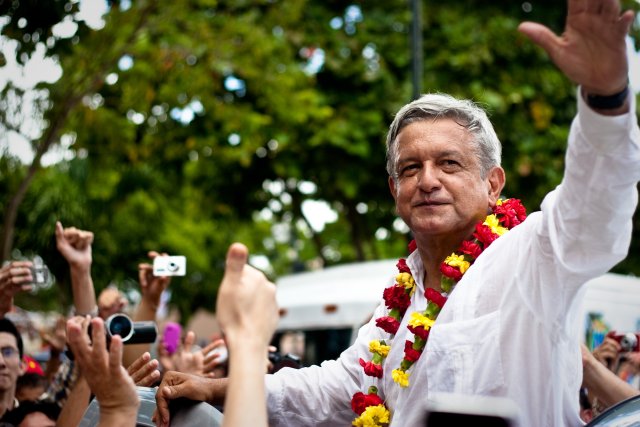
Much has been made of US President Donald Trump’s potential impact on Mexico, but one critical story has been largely ignored in the Western media.
Coverage of Mexico in the Trump era has been dominated by speculation over the fate of the stumbling Mexican peso, the possibility of the North America Free Trade Agreement (NAFTA) collapsing and, of course, the wall.
Meanwhile, a seismic shift is quietly taking place in Mexican politics: the right wing is the weakest it has been in generations, while the left is seeing a historic resurgence.
Although these trends began long before Trump’s surprise election victory, the impact of last November’s vote is clear to see in polling data.
On the same day as the November 8 US election, two leading Mexican newspapers released polls showing Margarita Zavala was set to comfortably win Mexico’s July 2018 presidential race.
Zavala is expected to be the candidate for Mexico’s right-wing National Action Party (PAN). She is also the wife of former president Felipe Calderon, who was responsible for launching Mexico’s widely despised, militarised drug war.
Both November 8 polls showed Zavala would win with well over 30% of the vote – a solid result for Mexican presidential elections. Her closest competitor, leftist Andres Manuel Lopez Obrador, commonly known as AMLO, trailed with around 25%.
Since then, however, the tables have turned, and pollsters now indicate AMLO is set to win by a landslide.
One poll conducted by El Financiero in January showed the leftist polling at 33%, with Zavala trailing by six percentage points. By March, Excelsior went as far as running an op-ed simply titled: “Presidente Andres Manuel Lopez Obrador”.
It may be a little premature to declare AMLO the winner of an election that is still more than a year away, but his growing popularity is becoming increasingly difficult to ignore.
AMLO narrowly lost the 2006 presidential election, after running on a platform of social justice and overhauling the country’s decrepit welfare system.
At the time, he was attacked by the Mexican right as a Hugo Chavez wannabe. AMLO attempted a comeback in 2012, but was soundly defeated by current right-wing president Enrique Pena Nieto, who won with 38% of the vote, compared to AMLO’s 32%.
Today, Pena Nieto is one of Latin America’s most unpopular leaders. In January, a survey by Reforma put his approval rating at 12%. That meagre result came after months of turmoil for the president, who has been battered by scandal after scandal.
The latest blow to Pena Nieto was his surprise announcement of a 20% petrol price hike in late 2016. The move sparked weeks of protests, some of which were accompanied by looting.
Meanwhile, Mexico’s currency has suffered since the 2015 collapse in global oil prices. In January, the peso hit a record low of less than 22 pesos to the US dollar – the currency’s worst performance since Mexico’s economic crisis in the early 1990s.
Yet it is not only the economy that is causing headaches for Pena Nieto. His campaign promises of cracking down on corruption and tackling violent crime have gone largely unfulfilled, leaving many of those who voted for him disappointed.
In other words, Mexicans were already looking for a political alternative long before Trump showed up. Nonetheless, it is hard to ignore the final nail in the coffin: Pena Nieto’s disastrous reaction to Trump.
Last August, the president infuriated many Mexicans by agreeing to meet with then-candidate Trump. It is not unusual for US presidential hopefuls to visit Mexico, but Pena Nieto’s decision to meet with a man who described Mexicans as “rapists” was controversial.
“He was really looking for trouble with this meeting,” veteran Mexican journalist and editor in chief of Caribe News, Olivier Acuna said at the time.
Acuna said many Mexicans were hoping Pena Nieto would secure an apology from Trump. But not only did Pena Nieto leave the meeting empty handed, just hours later Trump held a campaign rally in Arizona, where he doubled down on his anti-immigrant, anti-Mexico rhetoric.
As Acuna put it, Pena Nieto’s gambit was more than just another failure; it was the “cherry on top” of a long line of disappointments for Mexican voters. The already unpopular president was left looking weak.
Pena Nieto’s inability to handle Trump is emblematic of the Mexican right’s broader failure to come to terms with the new US administration.
For decades, Mexico’s right wing has maintained its legitimacy through an implicit pact with Washington: if we play ball with the US, then Washington will guarantee political and economic stability. That pact is dying, and it is taking the Mexican right down with it.
Meanwhile, AMLO has been tapping into widespread public disdain for Trump. In his latest rally on March 6, he told crowds in El Paso, Texas that Trump supporters were “victims of manipulation, a perverse effort to blame their problems on foreigners, particularly Mexicans.”
"On this side of the border, we must tell the four winds that the slogan of ‘United States first’ or ‘America first' is erroneous because in reality the first thing … should be justice and universal fraternity,” he said.
The juxtaposition could not be clearer. While Mexico’s right has fumbled over its reaction to Trump, AMLO has emerged as one of the staunchest advocates for Mexican national dignity.
Of course, AMLO is not the only leftist running in the 2018 presidential race.
He will be competing against a yet unnamed candidate from the radical left-wing Zapatista movement. The Zapatistas say they will officially name their candidate in May.
While it is unclear how well this mystery candidate will fare, it is clear that the Mexican left faces its best chance of gaining power in generations.
Ironically, this is – at least in part – thanks to Trump.
Like the article? Subscribe to Green Left now! You can also like us on Facebook and follow us on Twitter.